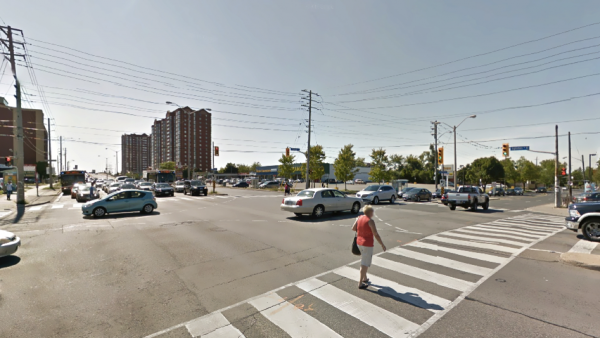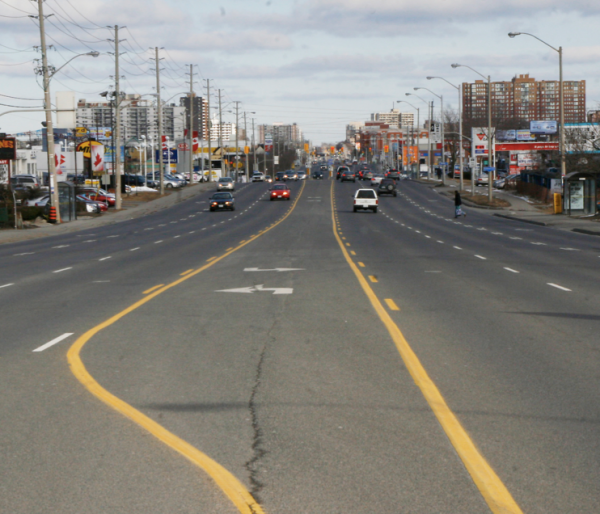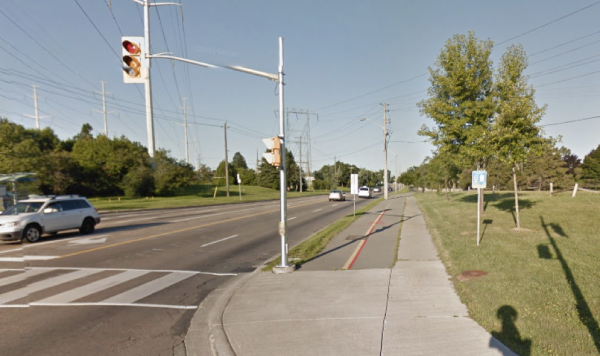This post by Michelle Kearns is part of Spacing’s partnership with the Toronto Cycling Think & Do Tank at the University of Toronto. Michelle is a graduate of U of T’s Master of Science in Planning program working in partnership with the Scarborough Cycles project at the Toronto Centre for Active Transportation. Scarborough Cycles is funded by the Metcalf Foundation’s Cycle City program, which aims to build a constituency and culture in support of cycling for transportation.
Scarborough was built for automobiles, this is true. Arterial roads are wide and fast, crossing distances at intersections are long, and winding residential streets are designed to keep traffic out (and at the same time this design restricts the use of these streets as safe cycling shortcuts). However, not everyone drives. TTC ridership counts point to heavily used routes such as Eglinton East (28,000 people on an average weekday), Lawrence East (33,700), and Victoria Park (24,800) (TTC, 2014), and since there is no comprehensive and detailed current walking or cycling data, TTC ridership is the closest we have to understanding how many residents are getting around without a private automobile. We know that car ownership in Scarborough is not nearly as common as what some may assume. There are significant numbers of residents getting around without cars in Scarborough. Even transit riders turn into pedestrians or cyclists when making the trip to or from the bus stop.


Over one month in late 2016, my colleague Trudy Ledsham and I held four focus groups in Southwest Scarborough with the goal of better understanding barriers to walking and cycling for transportation in the area. These focus groups were born out of a survey done by the Scarborough Cycles team when they had initially sought to generally understand travel in Scarborough. Thankfully for us, we were able to take advantage of one question on that survey: “Would you be interested in participating in a focus group on bicycling for transportation?” A total of 32 participants were still interested, months later, and chose to join us for a conversation.
We had expected the discussion to focus broadly on a lack of bike lanes and the challenges of crossing arterial roads, but instead we were privileged to learn about the participants’ daily lives and the unique mobility barriers they experience.
The focus groups included residents from various income groups, ages, and immigration status. Both high-rise dwellers and single-family homeowners participated. Many attendees were eager to tell their stories–of suffering a severe fall off a bike due to feeling forced to ride on the grassy boulevard and not the sidewalk or road, of poor lighting on sidewalks necessitating long route alterations on the way home, or of being passed too closely by fast-moving buses on Pharmacy Avenue while on a bike and fearing for their safety. Many saw TTC fare (and infrequent schedules) as barriers to go grocery shopping, taking their children to daycare, or running errands. Biking was helpful for some trips, but not feasible for many due to distance or the lack of a safe route. Biking to the nearest subway station (Victoria Park for most participants) would reduce commute time, but again, would require time spent on arterial roads—most participants in this case used the sidewalk. The bike parking station at Victoria Park was inaccessible to most—too expensive and too difficult to register as it must be done in-person at Union Station.
There was a sense of confusion for participants who were relatively new to the area when the Ford-era bike lane removal was brought up. For those who try to meander to the grocery store on their bikes, a bike lane on Pharmacy Avenue would have removed a significant barrier.
One of Scarborough’s best resources is the ravine trail system, but many participants felt unsafe exploring the isolated ravines on their own (as they thought there was little in the way of maps or wayfinding) or felt like they could not use these trails to commute as there was no lighting at night. Simply crossing the road was a barrier. Although all arterials are equipped with sidewalks and traffic lights at main intersections, the sheer distance that a pedestrian has to cross while cars attempt to turn across their path was a source of discomfort, especially for participants who were older, faced mobility challenges, or cared for small children.

This is a summary of the feedback and knowledge gained through this exercise. Thirty-two participants agreed to chat about their daily mobility challenges–many were passionate and truly believed some small changes could enhance safety and security for themselves and their neighbours. However, the system of “being heard” in Toronto is complicated. Councillors, community council, transportation services, the TTC–being new to Canada, having unpredictable schedules, dealing with a language barrier, or having a mobility barrier restricting access to some community consultations hindered many of these residents from accessing the traditional channels of advocating. Southwest Scarborough is a place of great diversity and rich culture, and it is a waste to not extend targeted effort at including these populations in discussing neighbourhood improvements. The narrative of Scarborough as an auto-dominated place where active transportation efforts would be wasted is difficult to overcome. Safety is a right for all–not just those who can navigate the complicated waters of power and representation in this City. It’s time that all modes of mobility are legitimized in Scarborough.

